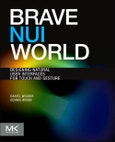Brave NUI World is the first practical guide for designing touch- and gesture-based user interfaces. Written by the team from Microsoft that developed the multi-touch, multi-user Surface� tabletop product, it introduces the reader to natural user interfaces (NUI). It gives readers the necessary tools and information to integrate touch and gesture practices into daily work, presenting scenarios, problem solving, metaphors, and techniques intended to avoid making mistakes.
This book considers diverse user needs and context, real world successes and failures, and the future of NUI. It presents thirty scenarios, giving practitioners a multitude of considerations for making informed design decisions and helping to ensure that missteps are never made again.
The book will be of value to game designers as well as practitioners, researchers, and students interested in learning about user experience design, user interface design, interaction design, software design, human computer interaction, human factors, information design, and information architecture.
Please Note: This is an On Demand product, delivery may take up to 11 working days after payment has been received.
Table of Contents
Part I: Introduction- Introduction
- The Natural User Interface
- Ecological Niche: Computing and the Social Environment & Ways of Working
Part II: Design Ethos of NUI
- Less is More
- Contextual Environments
- Spatial
- Social
- Seamless
- Super Real
- Scaffolding
- User Differentiation
Part III: New Technologies: Understanding & Technological Artefacts
- The State-Model of Input Devices
- Fat Fingers
- No Touch Left Behind
- Touch vs. In-Air Gestures
Part IV: Creating an Interaction Language
- MDA Revisited
- New Primitives
- Anatomy of a Gesture
- Makes a good Gesture Language
- Self-Revealing Gestures
- Mode and Flow of a Gesture System
Part V: No such thing as Touch
- Know your platform: Vision, Resistive, Capacitive, etc.
- The Fundamentals Have to Work
- Number of Contacts
- Contact Data: Shape, Pressure, and Hover
- Vertical/Horizontal/Mobile
Part VI: Process: How do You Get There?
- NUI UDI (User Defined Interface) and the Myth of the 'Natural Gesture Set'.
- False Recognition
- RITE With a Purpose
Part VII: Conclusion
- Conclusion: A word About Engineering








